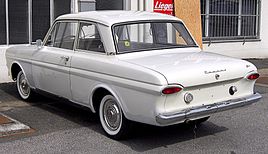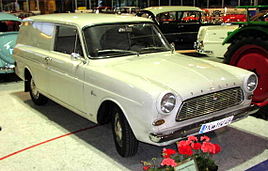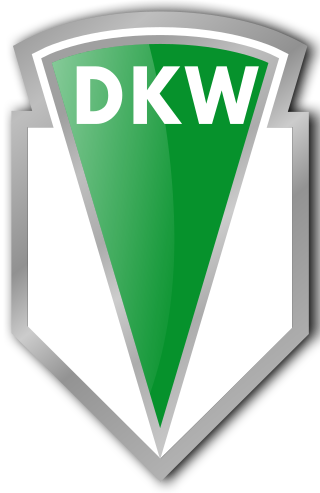
DKW was a German car- and motorcycle-marque. DKW was one of the four companies that formed Auto Union in 1932 and thus became an ancestor of the modern-day Audi company.

The Ford Taunus is a family car that was sold by Ford Germany throughout Europe. Models from 1970 onward were built on the same basic construction as the Ford Cortina MkIII in the United Kingdom, and later on, the two car models were essentially the same, differing almost only in the placement of the steering wheel. The model line was named after the Taunus mountain range in Germany, and was first made in 1939, and continued through several versions until 1994.
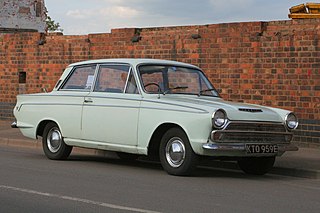
The Ford Cortina is a medium-sized family car manufactured and marketed initially by Ford of Britain, and then Ford of Europe in various body styles from 1962 to 1982 over five generations — and was the United Kingdom's best-selling car of the 1970s.

The Ford Sierra is a mid-size car or large family car manufactured and marketed by Ford Europe from 1982–1993, designed by Uwe Bahnsen, Robert Lutz and Patrick le Quément — and noted for its aerodynamic styling producing a drag coefficient of 0.34, a significant improvement over its predecessors.

The Opel Kadett is a small family car produced by the German automobile manufacturer Opel from 1936 until 1940 and then from 1962 until 1991, when it was succeeded by the Opel Astra.

In automotive design, a front-engine, front-wheel-drive (FWD) layout, or FF layout, places both the internal combustion engine and driven roadwheels at the front of the vehicle.
Economy car is a term mostly used in the United States for cars designed for low-cost purchase and operation. Typical economy cars are small, lightweight, and inexpensive to both produce and purchase. Stringent design constraints generally force economy car manufacturers to be inventive. Many innovations in automobile design were originally developed for economy cars, such as the Ford Model T and the Austin Mini.

The Ford Taunus V4 engine is a 60° V4 piston engine with one balance shaft, introduced by Ford Motor Company in Germany in 1962. The German V4 was built in the Cologne plant and powered the Ford Taunus and German versions of the Consul, Capri, and Transit.

The Opel Olympia is a compact car by German automaker Opel, then part of G.M., from 1935 to 1940, and after World War II continued from 1947 to 1953. It was one of the world's first mass-produced cars with a unitary body structure, after the 1934 Citroën Traction Avant; and it was a mass-production success, made in six-figure numbers. Opel achieved this even before the war, all while Hitler promised Germany a "Volkswagen" - a 'People's car', which didn't materialize until 1946. From 1967-1970 the Olympia badge was briefly reused on a later car.

The Ford Escort is a small family car that was manufactured by Ford of Europe from 1968 until 2000. In total there were six generations, spread across three basic platforms: the original, rear-wheel-drive Mk.1/Mk.2 (1968–1980), the "Erika" front-wheel-drive Mk.3/Mk.4 (1980–1992), and the final CE-14 Mk.5/Mk.6 (1990–2002) version. Its successor, the Ford Focus, was released in 1998, but the final generation of Escort was phased out gradually, with the panel van version ending production in 2002 in favour of the Ford Transit Connect.

The Datsun Cherry (チェリー), known later as the Nissan Cherry, was a series of subcompact cars which formed Nissan's first front-wheel drive supermini model line.

The automotive industry in Germany is one of the largest employers in the world, with a labor force of over 857,336 (2016) working in the industry.

The Ford Taunus P1 is a small family car which was produced by Ford Germany from 1952 until 1962. It was marketed as the Ford Taunus 12M, and, between 1955 and 1959, as the larger-engined Ford Taunus 15M. The company produced a succession of Ford Taunus 12M models until 1970, as the name was applied to a succession of similarly sized cars, but the first Taunus 12M models, based on the company's Taunus Project 1 (P1), remained in production only until 1962. In that year the Taunus P1 series was replaced by the Taunus P4 series.

The Ford Taunus 17 M is a middle sized family saloon/sedan that was produced by Ford Germany between September 1960 and August 1964. The Taunus 17M name had been applied to the car's predecessor and it would apply also to subsequent Ford models which is why the 17M introduced in 1960 is usually identified, in retrospect, as the Ford Taunus P3. It was the third newly designed German Ford to be launched after the war and for this reason it was from inception known within the company as Ford Project 3 (P3) or the Ford Taunus P3.
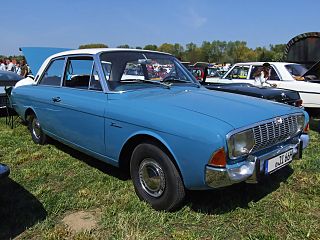
The Ford Taunus 17 M is a middle-weight family saloon/sedan that was produced by Ford Germany between 1964 and 1967. The entire range was first presented in September 1964 and volume production of the two and four door saloons/sedans began in November 1964. The "Turnier" version followed in January 1965 with coupé bodied cars coming along some time later.
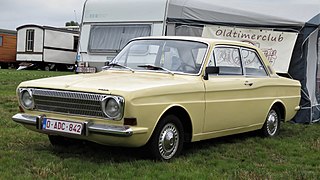
The Ford Taunus 12 M is a range of large family saloons/sedans that were produced by Ford Germany between 1966 and 1970. There were two different engine sizes in the 12M. Two larger engines were available in the otherwise very similar Ford Taunus 15 M. From the outside the 15M was differentiated by its grill and rectangular headlights from the 12M which had round front lights. A complicating feature was the availability, at extra cost, of one of the larger engines from the 15M in the 12M.

The Ford P7 is a range of large family saloons/sedans produced by Ford Germany between autumn 1967 and December 1971. The P7 was marketed as the Ford 17M, Ford 20M and Ford 26M.

The DKW Typ 4=8 is a small rear-wheel drive two-stroke V4 engined car produced at the company's Spandau plant by DKW. It was launched at the Berlin Motor-show in 1929 as a successor to the DKW Typ P built at the same factory, although the DKW Typ P 4=8 was significantly larger than the Typ P: in terms of market positioning a more direct successor to the DKW Type P was probably the DKW F1 produced in Zwickau from 1931.

The Ford Taunus TC is a range of large family cars that were built by Ford Germany from 1970 until 1982. The Taunus TC was based on the same basic construction as the Ford UK's Cortina range, with the "TC" badge standing for Taunus Cortina.
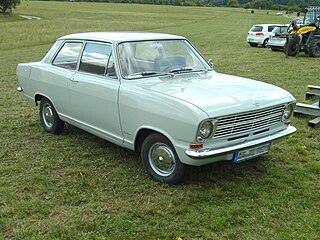
The Opel Kadett B is a car that was launched by Opel at the Frankfurt Motor Show in late summer 1965. The Kadett B was larger all-round than the Kadett A: 5% longer both overall and in terms of the wheelbase, 7% wider and 9% heavier, albeit 10 mm (0.39 in) lower in basic standard "Limousine" (sedan/saloon) form. Production ended in July 1973, with the successor model introduced a month later following the summer shut-down, in August. Unlike its predecessor, it had no relationship with the Vauxhall Viva, which had moved to its own platform for its corresponding second generation.

